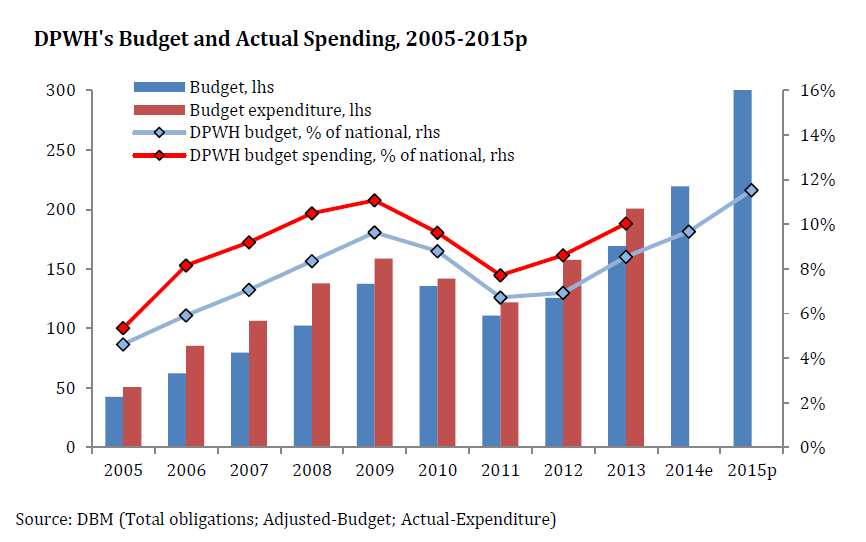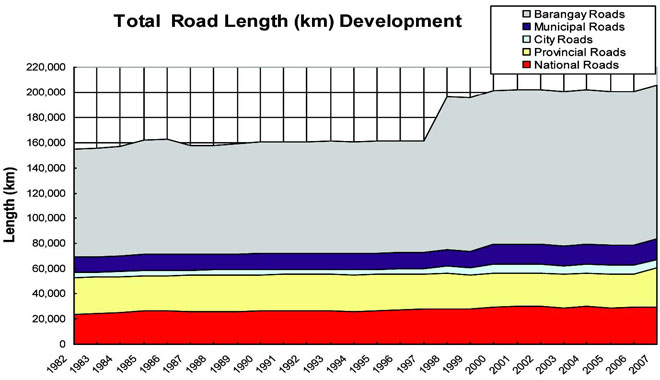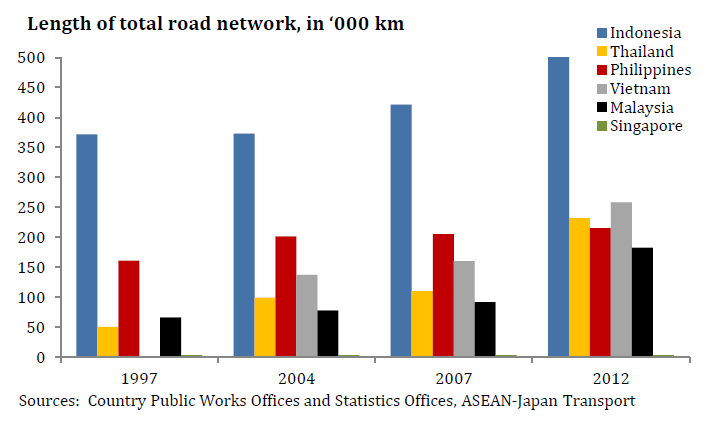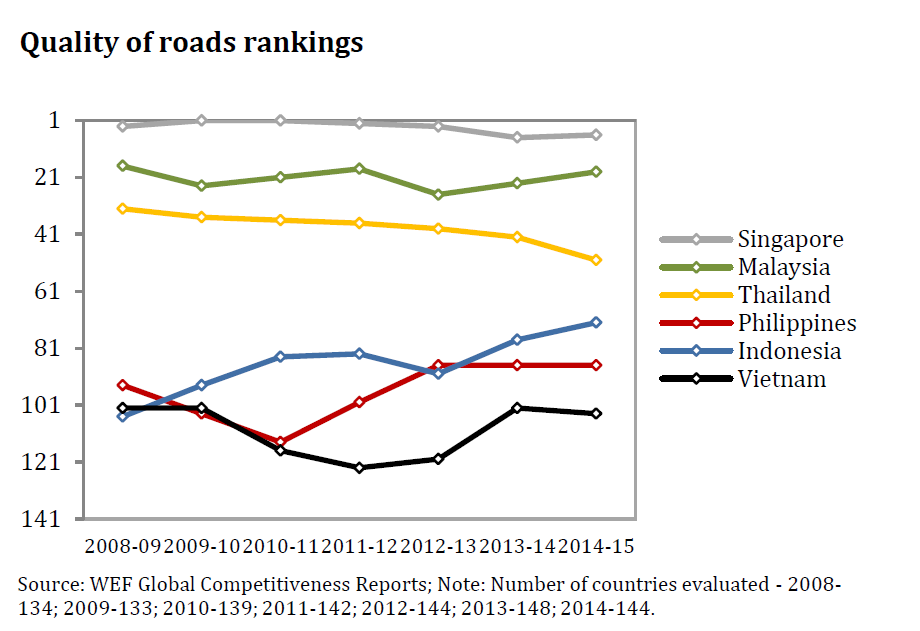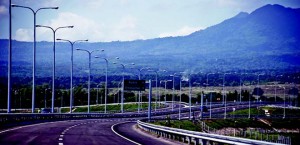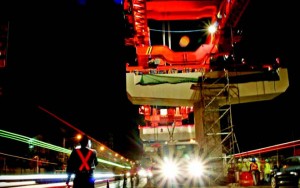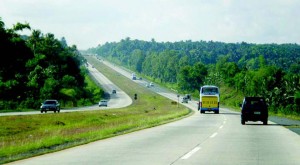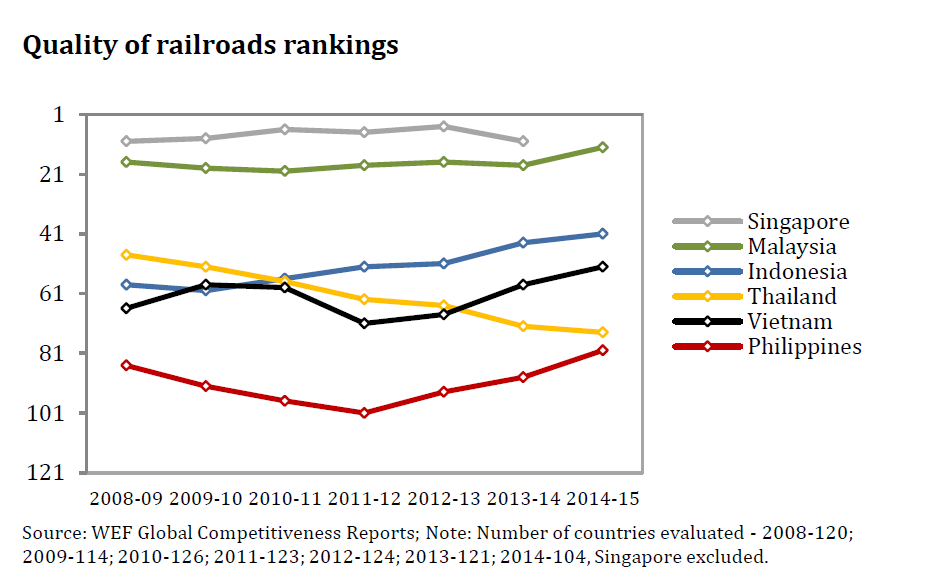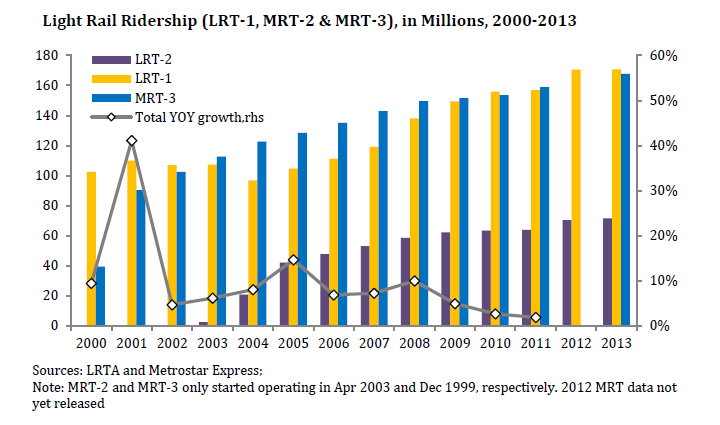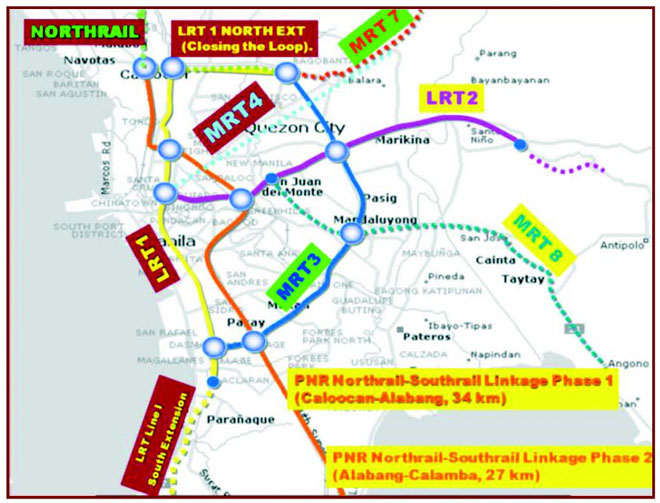Background (Roads and Rails)
Sector Background and Potential
Ground transportation infrastructure is essential for investment and job creation which are necessary to reduce poverty in the Philippines. It is a “catalyst” for area development and economic growth. Transport-logistics infrastructure such as roads and rail facilitate the efficient movement of goods and people. Absence of such vital infrastructure impedes the efficient movement of goods, increases transport cost, and ultimately impacts negatively on the country’s competitiveness.
Modern roads and rail support the high-growth sectors of BPO, manufacturing, and tourism. Modern toll roads and better farm-to-market roads provide tourists better access to destinations. In large urban areas particularly Manila a more extensive light rail system moves both employees and tourists more efficiently and eases traffic congestion on major thoroughfares.
The government allocated roughly PhP 889 billion to the development of transport infrastructure (roads, rail, light rails, airports, and seaports) under the 2006-2010 Medium Term Public Investment Program (MTPIP). For 2009, DPWH’s budget reached almost PhP 130 billion, the largest amount in the national budget and the highest level ever for the department (see Figure 82). The DPWH builds roads and bridges, school houses, and other public works. However, Figure 81 suggests that this increased spending has not raised the overall quality of roads.
One reason for the continued low rating of roads may be that much of the increased DPWH spending is going into CDF roads that are usually barangay roads (see Figure 83). As a result, national roads have barely increased in the last two decades. However, traffic on national roads certainly has. Anyone stuck for hours on EDSA or who tries to navigate the old MacArthur Highway north of Manila or the pre-SLEX road passing through the Laguna hometown of national hero Dr. Jose Rizal knows government funds are not improving these roads.
National roads are needed for efficient interprovincial movement of goods and people. One reason Philippine intercity traffic is becoming more congested is that the Philippines has not been adding to its stock of national roads for many years (see Figure 84).
A result of this distorted spending pattern is that Philippine roads are ranked poorly in international surveys (see Figure 85). Table 37 shows the percentage of paved roads and road density for Asian countries, showing the Philippines has a great distance to go before it can be ranked near Indonesia, Malaysia, and Thailand.
• Expressways
Modern efficient limited-access divided highways are essential for modern transportation around the world, some charge tolls, others do not. Some are owned by government, others by the private sector. We think of autobahns when driving in Germany and of interstate highways in the US. China has built the world’s second longest expressway system after the US in less than two decades, with a total length of 65,065 km. Japan and Korea have excellent expressways. While India has only approximately 200 km of expressways, the government has an ambitious plan to add 15,600 km during the next twelve years. 90
Such modern efficient roads are new in Southeast Asia. Malaysia has set the gold standard for the region with 1,500 km of expressways in operation and 200 km under construction. Malaysian and Indian toll expressways were built and are operated using the BOT/PPP financing and operating model to avail of private sector capital and management.
“To get rich, build roads first.”
—Old Chinese saying
Vietnam plans to build roads to get rich faster. In April 2010 Prime Minister Nguyen Tan Dung approved a US$ 18.4 billion plan to build a network of expressways by 2020. A total of 5,800 km of expressways, half of which running north-south and having 4 to 8 lanes, will be built. With its low labor and power costs, such an efficient highway system could make Vietnam the preferred economy in Southeast Asia for the China+1 strategy of multinationals locating additional factories in Asia.
While the Philippines has been slow to build and improve its limited network of expressways, it has had some success. There are seven limited-access toll roads operating or under construction in the country, all in Central Luzon.
1. The Subic-Clark-Tarlac Expressway (SCTEX), the newest tollway, financed with a US$ 425 million Japan Bank for International Cooperation (JBIC) loan, opened in 2008. SCTEX, operated by a private concessionaire, is owned by Bases Conversion and Development Authority (BCDA). The road unites the two former American military bases and greatly reduces the travel time from Manila to both, as well as improving connectivity with Tarlac province, Region 1, and the Cordillera.
2. The Manila-Cavite Expressway (also known as the Coastal Road) is a 6.6 km tollway under the Public Estates Authority Tollway Corporation (PEATC), a GOCC under the Office of the President. It extends from Roxas Boulevard in Parañaque to General Emilio Aguinaldo Highway in Bacoor, Cavite.
3. The Northern Luzon Expressway (NLEX) was the first limited-access tollway in the Philippines, built by the Philippine National Construction Corporation (PNCC) formerly owned by a businessman close to president Marcos. Granted a broad franchise for all toll roads on Luzon, PNCC built limited-access tollways north of Manila to San Fernando, Pampanga and south to Calamba, Laguna in 1968 and the early 1970s. The owner of PNCC fled the country when Marcos fell in 1986, leaving behind a bankrupt company taken over and held by the government since.
During the Ramos Administration, the Lopez Group was awarded a negotiated concession with PNCC to rehabilitate and operate the NLEX. Former president Ramos implemented a 2-lane extension by PNCC from San Fernando north to Dau, Pampanga in time for the 1998 Centennial Exposition at Clark. However, the Asian financial crisis delayed project financing until the US$ 371 million project was closed in 2003, and the rehabilitated and widened 84-kilometer tollway was opened in 2005 under the Manila North Tollways Corp (MNTC) with a 25-year franchise.91 In late 2008, the Lopez Group sold its 98% ownership of First Philippine Infrastructure, which owned 67% of MNTC to Metro Pacific Investments Corp, a Philippine subsidiary of First Pacific (Hong Kong), for US$ 278 million.
4. The Manila Skyway was built to relieve heavy traffic on the SLEX in the crowded southern suburbs of Metro Manila, after President Ramos during a 1993 visit to Jakarta arranged a joint venture between PNCC and Indonesian company PT Citra, owned by a daughter of President Suharto. PT Citra held a concession to build elevated expressways in Jakarta and a construction technology for building elevated freeways above crowded surface roads while allowing traffic to flow.92 Phase 1 of the project (Nicols to Sucat) cost some US$ 450 million and was financed with the AIG Asian Infrastructure Fund as the lead debt syndicator. Financing closed shortly before the onset of the 1997 Asian financial crisis. Citra Metro Manila Tollways Corporation also rehabilitated the portion of SLEX under the Skyway.
Financing for Phase 2 to Alabang was not arranged until a decade later, when local Philippine banks subscribed to US$ 400 million in loans. Philippine construction firm DM Consunji Inc (DMCI) expects to complete the Phase 2 project by the end of 2010.
Metropacific Tollways Corporation in April 2010 submitted an unsolicited proposal to construct and operate a 13 km expressway from the northern end of the Manila Skyway to Tondo, where it would connect with an expressway connecting the port of Manila with NLEX.
5. The 30-year old Southern Luzon Expressway (SLEX) waited a decade for the implementation of the planned upgrading after completion of the Manila Skyway. Proposals by local and foreign proponents, government, and the private sector were made but abandoned. Finally, the SLEX Upgrading and Rehabilitation Project started in mid-2006 led by MTD Capital Bhd of Malaysia through MTD Manila Expressway Corporation in joint venture with franchise-holder PNCC in the South Luzon Tollway Corporation (SLTC). The SLEX upgrading project is near completion and will eventually connect to the STAR Tollway. Phase 1 of the project retrofitted and widened the Alabang Viaduct. Phase 2 rehabilitated and widened the Alabang-Calamba segment of SLEX. Construction of the Phase 3 Calamba-Santo Tomas segment will connect to the STAR Highway. When complete, the SLTC will take over management and operation of SLEX and STAR. Driving time from Makati to Batangas should be cut in half to only 90 minutes.
6. The Southern Tagalog Arterial Road (STAR Highway) was the third tollway project initiated by former president Ramos and connects SLEX to Batangas Port. A 4-lane section of the Star Highway built by the DPWH was opened in the late 1990s but right-of-way challenges prevented full completion during the subsequent decade. Two lanes were opened from Lipa to Batangas. STAR will eventually be a 4-lane 42 km expressway from Santo Tomas to Batangas City and is being completed by the DPWH.
7. In 2008, a BOT contract for the 85-kilometer Tarlac-La Union Expressway was awarded to the Private Infrastructure Development Corp (PIDC) following a reportedly solicited bid. Phase 1 (NEDA estimate PhP 17 billion) should start construction in 2009 to build two lanes; the remaining two lanes are to be built under Phase 2 by 2013.The government will provide the right-of-way. After the project is built, the GRP will grant the proponent a franchise to operate and maintain the road, and the Toll Regulatory Board (TRB) will issue a certificate to operate a toll road under a long term concession agreement.
A mixture of Philippine and foreign equity investors in tollway operating firms, Philippine government agencies, JBIC loans, and commercial debt have contributed to the significant activity in the construction and rehabilitation of toll roads over the last decade in Central Luzon. An estimated US$ 2 billion has been invested in these projects.93
Due to the scale, number, and complexity of the infrastructure investments in the Philippines, a relatively small group of people and institutions understands how infrastructure investment decisions are made and implemented. As a result, at times, infrastructure investments can be misallocated and delayed. At worst, leakages from infrastructure projects sap the country of much-needed infrastructure investments.
• Rail Transportation
The geography of the Philippine archipelago does not lend itself to an extensive rail network. Only a few routes in heavily-populated regions would justify the expense of a railroad instead of a road system. Railroads require an considerable traffic of goods or passengers between stations and their place of origin or destination. However, light rail for passenger transport in large urban areas is an ideal investment in public transportation. No other system can carry more people in less space on a dependable time schedule at less cost.
Figure 86 shows comparative railroad infrastructure rankings of the ASEAN-6. The ratings measure intercity rail service, which has long been extremely poor in the Philippines. Indonesia has managed to maintain its passenger service across Java, although crowded, and Vietnam has rebuilt its service from the Chinese border to Ho Chi Minh City that was destroyed during 40 years of war. Malaysia and Thailand have had reputable rail systems for many decades. Only in the last decade has the Philippines begun to improve its intercity rail service and to use more of its installed but abandoned right-of-way. However, the projects are not yet implemented and their benefits for the public not yet realized.
China has become not only the world leader in building railroads but also has leapfrogged in high-speed rail technology. Although the country had 86,000 km of rail at the end of 2009, much is overcrowded in light of China’s huge population, carrying a quarter of the world’s rail traffic on a mere six percent of the world’s railroad tracks. In reaction to the global financial crisis, the government accelerated its plan to increase rail lines to 120,000 km, and six million new jobs were created under a massive program that has 33,000 km under construction. China is emphasizing high-speed rail. It has rapidly built the longest high-speed rail network in the world, which it hopes to double to 13,000 km by 2012. For example, the high-speed rail line under construction between Beijing and Shanghai will cut travel time to 4 hours from 10 hours. 94
Korea has only introduced high-speed rail in recent years with a 240 km line from Seoul to Busan and Mokpo. Closer to the Philippines, the Taiwan High Speed Rail (THSR) runs 336 km from Taipei to Kaohsiung which carried more than 10 million passengers in 2007, its first year of operations. The THSR is one of the largest privately funded transport schemes; total project cost has reached US$ 15 billion.
The race to be the first country in Southeast Asia to build a high-speed rail has begun. Five countries have solid plans or proposals for high-speed rail: 95
• Indonesia: The Hydrogen Hi-Speed Rail Super Highway (H2RSH) train to the Jakarta Soekarno-Hatta International Airport is under construction and due for 2012 operation. Caedz LLC a San Francisco-based economic re-engineering firm led by a consortium of multinational investors signed a Memorandum of Agreement with the Indonesian firm Kadin in December 2009 in Los Angeles, USA.
Indonesia has expressed an interest in high-speed rail linking Jakarta, Bandung, and Surabaya. The Department of Transportation announced it was seeking investors for a 683 km high-speed line between Jakarta and Surabaya, expected to cost US$ 6 billion. Proposals had been submitted by Chinese, French, and German firms.
• Malaysia and Singapore: A high-speed rail to link Kuala Lumpur and Singapore was proposed in 2006 by YTL Corporation. It would cut travel time to 90 minutes, compared with 4 hours driving and 7 hours on the current rail line. A Bangkok – Kuala Lumpur – Singapore line has also been suggested. Siemens has expressed interest in being the technology provider.
• Thailand: The Thai Ministry of Transport has plans for several high-speed rail lines. In October 2009, it was reported that funding was being sought for four lines, linking Bangkok to Chiang Mai (711 km), Nong Khai (600 km), Chanthaburi (330 km), and Padang Besar (983 km). In November, the Thai cabinet approved the plan, with the shorter route to Chanthaburi intended for construction first. The total cost of all routes is US$ 25 billion.
• Vietnam: Vietnam Railways is planning a 1,555 km high-speed link from Hanoi to Ho Chi Minh City, costing US$ 33 billion and cutting current travel time from 30 to less than 9 hours. Funding is expected to come from Japan and would most likely involve Shinkansen technology.
• Philippines: The Department of Transportation has no plans for high-speed rail. 96 San Miguel Corporation has proposed a bullet train system connecting Laoag City to Manila to the Bicol region.
Despite some talk about high-speed rail, intercity rail in the Philippines remains closer to its 19th century origins than the 21st century. Philippine National Railways (PNR) originated in a Spanish privately owned rail line running north from Manila to Dagupan in Pangasinan and nationalized in 1916. Service was extended in 1938 to Legazpi in Bicol. After 1946, the US Army, which was rehabilitating the destroyed system, transferred the railroad to the Philippine Government. It remained a GOCC and only operated service on its southern Manila-Legazpi route, named the Bicol Express, but anything but that.
The DOTC has sought to restore rail service north of Manila since early in the Ramos Administration. A project with Spanish and Filipino investors was pursued in the 1990s but eventually abandoned for lack of financing. Subsequently, former House Speaker Jose de Venecia facilitated a People’s Republic of China (PRC) loan of over US$ 400 million for the first Phase. The PRC has also financed Phase 2 of North Rail. There have been many allegations that corruption and overpricing were involved in the project, which has progressed slowly.
PNR’s North Rail commuter rail project is designed to serve eight stations between Caloocan (Manila) and Clark (Pampanga). However, in October 2008 there were reports that the Chinese partners proposed a change in engine technology from diesel to electric and considerable cost increases that require NEDA ICC approval. Meanwhile, the COA determined government procurement bidding procedures were not followed.
All light rail lines in the Philippines are located in Metro Manila. While intercity rail in the country is extremely minimal, three lines currently operate giving the NCR a solid basic network. One additional line is approaching financial closure. There also are additional lines planned which can be financed and built whenever the government’s slow transportation bureaucracy acts more decisively.
• The Light Rail Transit Authority (LRTA) operates the government-owned LRT-1 (Yellow Line from Baclaran to Monumento) and LRT-2 (Purple Line from Santolan to Recto). Some 30 years old, LRT-1 was financed with Belgian government trade credits and later received new JBIC-financed equipment. 97 LRT-2 (or Line 2) was built through a concessional loan of some US$ 1 billion from the JBIC. Line 2 began operations in April 2003 and became fully operational by October 2004. The DOTC is financing construction of a short line in the northern part of Metro Manila with four stations to link LRT-1 and MRT-3 (which are connected in the south at the intersection of EDSA and Taft Avenue) to begin operating in 2010.
• The only light rail line built as a BOT project, Metro Rail Transit-3 (MRT-3) (Blue Line from Taft to North Avenue) began operations in December 1999. MRT-3 was initially owned by a consortium of Filipino companies that lost the bid for the US$ 1.5 billion Fort Bonifacio land privatization and decided to invest in the rail project for its real estate potential. Its original Israeli proponent and American project manager held small equity positions. The original partners sold out and most equity is held by foreign private equity investors in London and New York. The public utility part of the MRT-3 project (which must be at least 60% Philippine equity) interacts with the public by ticket selling, scheduling, and the like. The foreign-owned company owns and operates the actual light rail system, for which it receives an annual fee from the DOTC at a rate of return of 15%. A 1995 Supreme Court decision supports this ownership distinction. The DOTC is in the process of acquiring the line from its investor-owners.
• A second BOT project, MRT-7 light rail project on Commonwealth Avenue was contracted in mid-2008 by the DOTC after seven years of negotiation by its foreign developer. At US$ 1.2 billion, MRT-7 is the most expensive BOT project yet undertaken in the Philippines. Its present equity structure is majority Philippine.
• The long-delayed LRT-1 South Extension Project servicing fast-growing Cavite province is an excellent candidate for a solicited BOT to foreign operators and developers. For several years, a prominent Canadian company tried to undertake the project as a joint venture with the LRTA but eventually abandoned it because of lack of progress. Then the World Bank/IFC offered a loan for public works and technical assistance for an international bid. While the DOTC was considering this proposal, a PRC construction firm China Shanghai Corporation for Foreign Economic and Technological Cooperation (SFECO) proposed building the LRT-1 project under a government-to-government arrangement with Chinese concessional trade credits. LRTA chairman DOTC Secretary Mendoza, failed to decide which financing scheme to use, despite strong recommendations from foreign and Philippine business groups, foreign embassies, and NEDA to bid out the project. Such indecision demonstrates the adverse effect of PRC ODA on Philippine development plans and has been a disservice to Philippine citizens who otherwise could ride a modern transport system. 98
LRT lines 1 and 2 are under LRTA, an attached agency of DOTC, while the MRT-3 is directly under the DOTC. The LRT-1 to MRT-3 connection is not seamless (due to technical issues, i.e., differences in signaling system, etc.). Also, differences in accounting systems prevent the issuance of one ticket that would work on all lines.
Figure 87 show the steady increase in ridership on the Metro Manila light rail lines. Over 350 million passengers traveled on the system in 2009, with MRT-3 nearly equaling the much older LRT-1 line. The most expensive line – LRT-2 – carries fewer passengers. The rate of growth in ridership has been strong. If the additional planned lines are constructed, annual ridership could reach one trillion within the decade.
Map 2 shows present and future light rail lines in the NCR. LRT-1 (yellow) now connects to MRT-3 (blue) at North Avenue, although passengers have to walk to transfer between the two lines, as they also have to do at Taft Avenue and EDSA. LRT-2 (purple) will have extensions to the east and the west. LRT-1 will extend south into Cavite (dotted yellow). Proposed MRT-4 (light blue) connects downtown Manila to MRT-7 along Commonwealth Ave in Quezon City. Proposed MRT-8 connects downtown Manila with the eastern suburbs of the megalopolis.
Footnotes
- The figure was revealed by China’s Minister of Communications as reported by Xinhua News <https://news.xinhuanet.com/english/2010-01/15/content_12817685.htm>. India has some 10,000 kilometers of four lane highways which are not limited access and can be congested and dangerous (National Highways Authority of India.).[Top]
- Four shareholders came together to put up MNTC: First Philippine Infrastructure Development Corporation (FPIDC), the infrastructure arm of the Lopez Group; Egis Projects S.A. of France, reputedly the world’s biggest tollway operator; Leighton Asia Ltd. of Australia, a civil works specialist with an extensive track record in toll road construction; and Philippine National Construction Corporation (PNCC), the state-owned company that holds the franchise for the operation of the expressway. (From MNTC website www.mntc.com)[Top]
- The concrete elevated roadbed supports were cast in the center divider parallel to traffic using the existing surface road, then raised hydraulically and rotated 90 degrees.[Top]
- Author’s rough estimate of US$ 400 million each for SCTEX, NLEX, SLEX-STAR, and Skyway.[Top]
- “Inside Asia” by Alan Wheatley, IHT, April 13, 2010[Top]
- Information on Korea, Taiwan, and SEA are from Wikipedia’s numerous entries under High-speed Rail especially “Planned high-speed rail by country.”[Top]
- Transportation Secretary Mendoza at a forum on airport and rail transportation in November 2008 pointed to the Northrail project as sufficient to connect Manila to Clark and said he did not believe high-speed rail would be possible in the Philippines.[Top]
- LRT-1 has sometimes carried over a half million passengers in one day. On January 9, 2009 582,989 passengers took Line 1 during the Feast Day of the Black Nazarene.[Top]
- There were reports that influential private persons with strong connections to Malacañang favored a PRC government-to-government loan. The JFC wrote DOTC Mendoza on October 3, 2008 urging a transparent international BOT/PPP bidding[Top]











